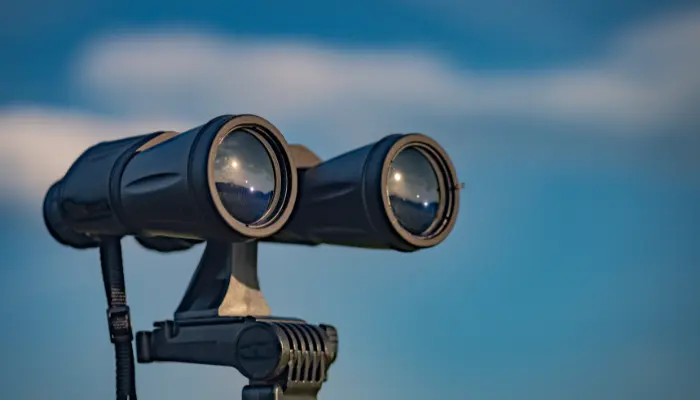This post may contain affiliate links which means I may receive a small commission for purchases made through the links. Learn More
No doubt that binoculars are super helpful tools, Unfortunately, these devices are usually quite fragile, and they can break or become damaged over time. For binos users, having proper information about repairing binoculars is inevitable as it will help you save from spending bucks by calling a professional mechanic.
I have seen many people who abandon their binoculars when they get a slight fault because they don’t know how to repair their binoculars at home. If you are one of them, this guide is going to be a must-read for you as I will provide step-by-step instructions for common repairs. Let’s get started.
Related Article: How to Fix Binoculars With Double Vision?
Required Tools for Repairing Binoculars
Repairing binoculars at home requires a few tools and materials to get started. Without these tools and equipment, you won’t be able to repair your faulty binos.
Here are some of the essential tools that you must gather before beginning the repair process:
- Pliers
- Adhesive
- Tweezers
- Lubricant
- Screwdriver
- Lens cleaning kit
- Cleaning solution
Keep in mind that having all the above-mentioned tools will make the process smoother and quicker.
How to Repair Binoculars at Home: Lens, Prisms, Focus Knob?
When it comes to repairing binoculars at home, the lens, prisms, and focus knob are the three most important parts that often get faulty when mishandled. In my lifetime experience, I have noticed that these three parts are the most fragile. In the section below, I will explain the whole process of repairing these components.
1- Repairing Lenses at Home
Before starting to repair lenses, I recommend you to:
- Examine both the objective lenses (front) and the eyepiece lenses (rear) to determine which lens requires repair.
- Take note of any scratches, cracks, or other damage.
Once you’re familiar with the damaged lens, then you can start the repair process that I am going to explain in the section below.
To repair lenses, you will need to locate lens screws. If they are covered under the rubber coating, use the manual and mark their placement on a piece of paper to help you remember their respective positions.
Once you have located the lens screws, then take a small screwdriver and open the lens screws. For most binoculars, they can be found at the top of both lenses.
Once you have unscrewed the nuts, then you can remove the lenses. Most of the time, the lenses malfunction because of dirt, debris, and contaminants getting accumulated there.
I highly recommend you clean them. If they’re relatively clean, all you need to use is a microfiber cloth, but if they’re filthy, you can use a cleaning solution and make sure that all the dirt is removed.
Related Artice: How to Clean Binoculars?
After cleaning, dry the lens in an open space. When it is dry, you need to measure the inside of your binoculars by measuring the center point of your lens. Reinstall the lens at the center point, avoiding using your fingers as this can smudge your cleaned lens with your fingerprints.
If there are small scratches on the lenses of binoculars, then you can try using a lens repair adhesive. Apply a small amount of adhesive to the scratched area and use a toothpick or cotton swab to spread it evenly.
If you see that the lenses are broken or severely scratched due to falls or shocks, then I recommend you remove the lenses and replace them with new ones. You can buy new lenses from any optical store. To buy new lenses, you will have to tell them your binos’ model.
Once the lenses are repaired or replaced, then carefully reattach the eyepiece covers and secure them with screws or clips. Adjust the focus wheel and look through the binoculars to ensure the repaired lenses have improved image quality.
2- Repairing Prisms at Home
If the lenses are in fine working conditions, then chances are high that there might be an issue with the prisms. First of all, locate the prism assembly. The prism assembly is typically located near the eyepiece end of the binoculars.
So, you need to remove the prism cover. Use a screwdriver to remove the screws that hold the prism cover in place. With the help of a screwdriver, you will be able to remove the prism.
Once you have access to the prism, I recommend you check the alignment of the prism. Damaged or misaligned prisms won’t let you see everything clearly. If the prism is damaged beyond repair, consider purchasing a replacement prism.
If the prism is not broken or scratched, then I recommend you clean the prism and assemble all the optical components of the binoculars. Use a clean, lint-free cloth to gently wipe away any dust, dirt, or debris from the prism and surrounding areas.
Once the cover is removed, remove the prism and clean it with a soft cloth. Be careful not to scratch the prism surface. After cleaning, reinstall the prism and cover and reassemble all the optical components that you removed before and test the performance of binos.
Also Read: How Do Binoculars Work?
3- Repairing Focus Knob at Home
To repair the focus knob, you need to remove the focus knob cover. Use a screwdriver to remove the screws that hold the cover in place. Once the cover is removed, you’ll get access to the focus knob.
But the question might come to your mind about what issue the focus knob can get. Look, the overuse of binoculars, and more particularly the focus knob result in friction, and you won’t be able to move the knob or wheel smoothly.
To fix this issue you’ll need grease and cotton buds. Once you have access to the focus knob then apply a small or thin layer of grease on the focus knob with the help of cotton buds. Make sure not to apply too much grease as it will make the knob too slippery.
Note: Before applying the grease, I highly recommend you use a soft cloth to remove any dirt or debris. If the dust remains there and you apply the grease, it won’t solve your problem – in fact, it will worsen the situation.
How to Disassemble the Binoculars for Repairing?
As you have seen above, I told you to disassemble the interior optical component for repair. But many people don’t know how to disassemble the binoculars and fear that they will damage the components. Don’t worry as I am not leaving you alone.
Disassembling binoculars at home requires some basic tools and knowledge. In the section below, I will guide you about disassembling the different parts of binoculars.
1- Removing the Eyepiece Covers
During disassembling, the first thing that you will need to remove is the eyepiece covers. These covers are usually held in place by a small screw or a snap-on mechanism.
I recommend you use a screwdriver or a small flat tool to remove the screws or pry open the snap-on mechanism. Once the covers are removed, the eyepieces are exposed. In case you have an eyepiece you can repair it.
2- Removing the Focusing Wheel
Most binoculars usually get their focus wheel damaged. I don’t know the reason but this is pretty much common across all the binoculars. In the upcoming section, I will guide you on how you can remove the focusing wheel.
The focusing wheel is usually located in the center of the binoculars and is held in place by a screw or a snap-on mechanism. You can use the screwdriver to unscrew the nuts which hold this knob. Once the focusing wheel is removed, the binoculars’ internal parts are exposed and you’ll be able to repair them.
3- Removing the Prism Covers
The prism covers are located on the sides of the binoculars and are held in place by screws. They are also present inside the binoculars’ bodies. To remove the prism or get access to the prism cover, you will have to remove the nuts and their prism cover will be removed quite easily.
Frequently Asked Questions
Yes, it is possible to repair binoculars at home if you have the right tools and knowledge. You can fix almost all the common issues that can be fixed with a little bit of effort.
If your binoculars are loose or misaligned, you can fix them by adjusting the screws that hold the lenses in place. Use a screwdriver to tighten the screws until the lenses are securely in place.
There are many things that can go wrong with binoculars, including misaligned lenses, loose screws, and damaged focus mechanisms. scratched or dirty lenses, and broken or cracked bodies These issues can be caused by regular wear and tear, mishandling, or exposure to extreme outdoor conditions.
Conclusion
In this guide, I have gone into depth and given all the possible solutions to common problems that binoculars usually get. No matter if your binoculars have faulty lenses, prism, or focus knob, you can fix all these issues just by following my mentioned method. I hope that this guide will be useful for you. If you have any questions in mind, you can ask in the comment section.

Miqdad is a passionate outdoor adventurer and an expert in optics. He holds degrees in the field and his love for exploring nature up close with binoculars has driven him to research and deepen his knowledge of optics. All the content present on this website is written by Miqdad as he is a proficient writer as well.

